check engine AUDI A7 2016 Owner's Manual
[x] Cancel search | Manufacturer: AUDI, Model Year: 2016, Model line: A7, Model: AUDI A7 2016Pages: 294, PDF Size: 73.82 MB
Page 217 of 294
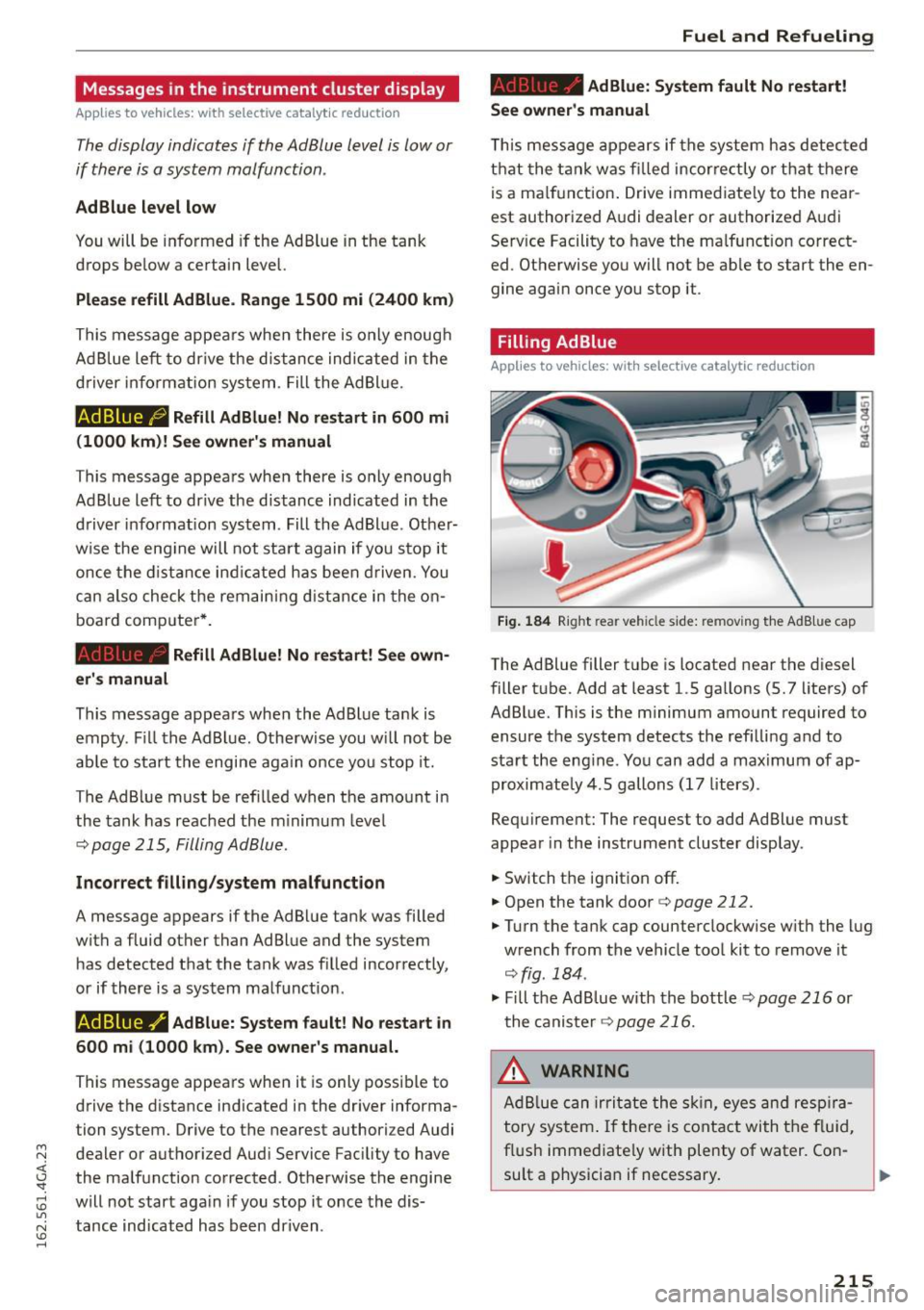
M N <( I.J "". rl I.O
"' N I.O rl
Messages in the instrument cluster display
Applies to vehicles: with selective catalyt ic reductio n
The display indicates if the Ad Blue level is low or
if there is a system malfunction .
AdBlue level low
You will be informed if the Ad Blue in the tank
drops be low a certain level.
Please refill Ad Blue. Range 1500 mi (2400 km )
This message appea rs whe n there is o nly enoug h
Ad B lue left to dr ive the d ist ance ind icated in the
d river i nfo rmation sys tem . Fill the AdBl ue.
Ad Blue ,0 Refill AdBlue! No restart in 600 mi
( 1000 km)! See owner 's manual
This message appea rs when there is o nly enoug h
Ad Blue left to dr ive the distance indicated in the
d river info rmation system . Fill the Ad Blue . Othe r
wise the eng ine will not sta rt again if you s top it
once the di stan ce in dicated ha s been driven. You
can also check t he rem ain ing distance in the on
board comp ute r*.
Refill Ad Blu e! No restart! See own -
er' s manual
This message appea rs whe n the AdBlue tank is
empty . Fill t he AdBl ue. Othe rw ise you w ill not be
ab le to start the engine aga in once yo u stop it.
T he AdBlue must be refi lled when t he amo unt in
the tank has reac hed the m inimum leve l
q page 215, Filling Ad Blue .
Incorrect filling/system malfunction
A message appears if the AdBl ue tank was filled
with a fluid other than AdBlue and the system has detected t hat the ta nk was f illed incor rectly,
or if there is a sys tem ma lf u nction .
Ad Blue -I' Ad Blue: System fault! No restart in
600 mi (1000 km). See owner's manual.
This message appea rs when it is only poss ible to
drive the d istance ind icated in the dr iver informa
tion system. Drive to the nearest authori zed Audi
dealer or authorized Aud i Service Fac ility to have
the ma lfunction corrected . Otherwise the engine
w ill not start aga in if you stop it once the dis
tance ind icated has been driven .
Fuel and Refueling
AdBlue: System fault No restart!
See owner's manual
T his mes sage ap pea rs if t he system h as detec ted
t h at the t ank was fi lled incor rectly o r tha t there
is a ma lf u nction . Drive immed iate ly to the near
est authorized A udi dealer or autho rized A udi
Se rv ice Facility to have the ma lf u nction co rrect
ed. Otherwise yo u will not be ab le to start the en
gine aga in once you stop it .
Filling AdBlue
Applies to vehicles: with selective catalytic reduction
Fig. 184 Rig ht rea r ve hicle s ide: re m oving t he AdB lu e cap
The Ad Blue filler t ube is located near the diesel
filler t ube . Add at least 1.5 ga llons (5.7 liters) of
AdBl ue. This is the m inimum amount required to
ensure the system detects the refi lling a nd to
start the eng ine . Yo u can add a max imum of ap
proximate ly 4.5 gallons (17 liters) .
Req uirement: The request to add Ad Blue must
appear in the instrument cluster display .
.. Switch t he ignit ion off .
.. Open the tank door
q page 212.
.,. Turn the tank cap counterclockwise w it h the lug
w rench from the vehicle too l kit to remove it
q fig . 184 .
.,. Fill the Ad Blue with th e bottl e ~ page 216 or
the caniste r<=>
page 216.
.&_ WARNING
Ad Bl ue can irri tate the skin , eye s and respira
tory sys tem . If the re is con tact with t he flu id,
f lush imme diate ly w ith plenty of water. Co n-
su lt a physicia n if necessary. .,,_
215
Page 220 of 294
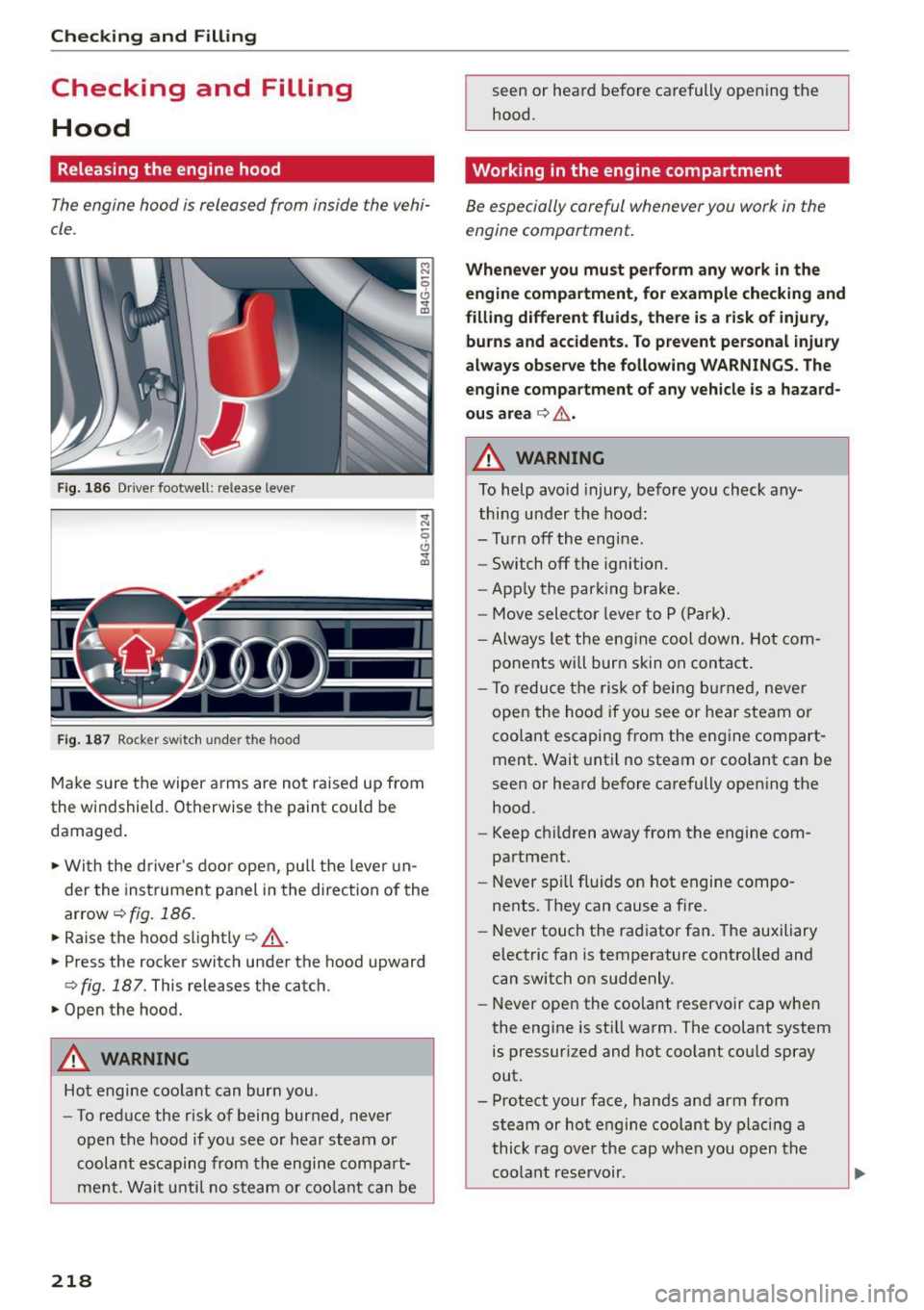
Checking and Fill in g
Checking and Filling
Hood
Releasing the engine hood
The engine hood is released from inside the vehi
cle.
Fig. 1 86 Driver footwell: release lever
Fig. 187 Rocker sw itch under the hood
Make s ure the wiper arms are not ra ised up from
the windshield . Otherwise the paint could be
damaged .
.. Wi th the driver's door open, pu ll the lever un
der the instrument panel in the direction of the arrow
c::> fig. 186.
.. Raise the hood s lightly c::> _A .
.. Press the rocker switch under the hood upward
Q fig. 187. This releases the catch.
.. Open the hood.
A WARNING
Hot engine coo lant can burn you.
- To reduce the risk of being burned, never
open the hood if yo u see or hear steam or
coolant escap ing from the engine compa rt
me nt. Wait until no steam or coo lant can be
218
seen or heard before carefully open ing the
hood.
Working in the engine compartment
Be especially careful whenever you work in the
engine compartment.
Whenever you mu st perform any w ork in the
engine comp artment , for example checking and
filling d iff erent fluid s, the re i s a risk of injury ,
burns and accidents. To p revent pe rsonal injur y
alwa ys ob serv e the follow ing WARNING S. The
engi ne compartment o f an y vehicle is a h azard
ous are a
i::>_6 .
A WARNING
To help avo id injury, before you check any
thing under the hood:
- Turn off the engine.
- Switch off the ignition.
- App ly the parking brake.
- Move selector leve r to P (Park).
- Always le t the eng ine cool down. Hot com-
ponents wi ll burn skin on contact .
-
-To reduce the risk of bei ng bur ned, never
open the hood if you see or hear steam o r
coo lant escaping from the engine compart
ment . Wait unt il no steam o r coolant can be
seen or heard before carefully open ing the
hood.
- Keep c hildren away from the engine com
partment .
- Never sp ill fluids on hot engine compo
nents. They can cause a fire.
- Never touch the radiator fan. The auxiliary
electric fan is temperature cont ro lled and
can switch on suddenly.
- Never open the coolant reservoir cap when
the engine is sti ll warm. The coolant system
is pressur ized and hot coo lant co uld spray
out.
- Protect your face, hands and arm from
steam or hot engine coolant by placing a
thick rag ove r the cap w hen you open the
coo lant reservoir.
Page 221 of 294
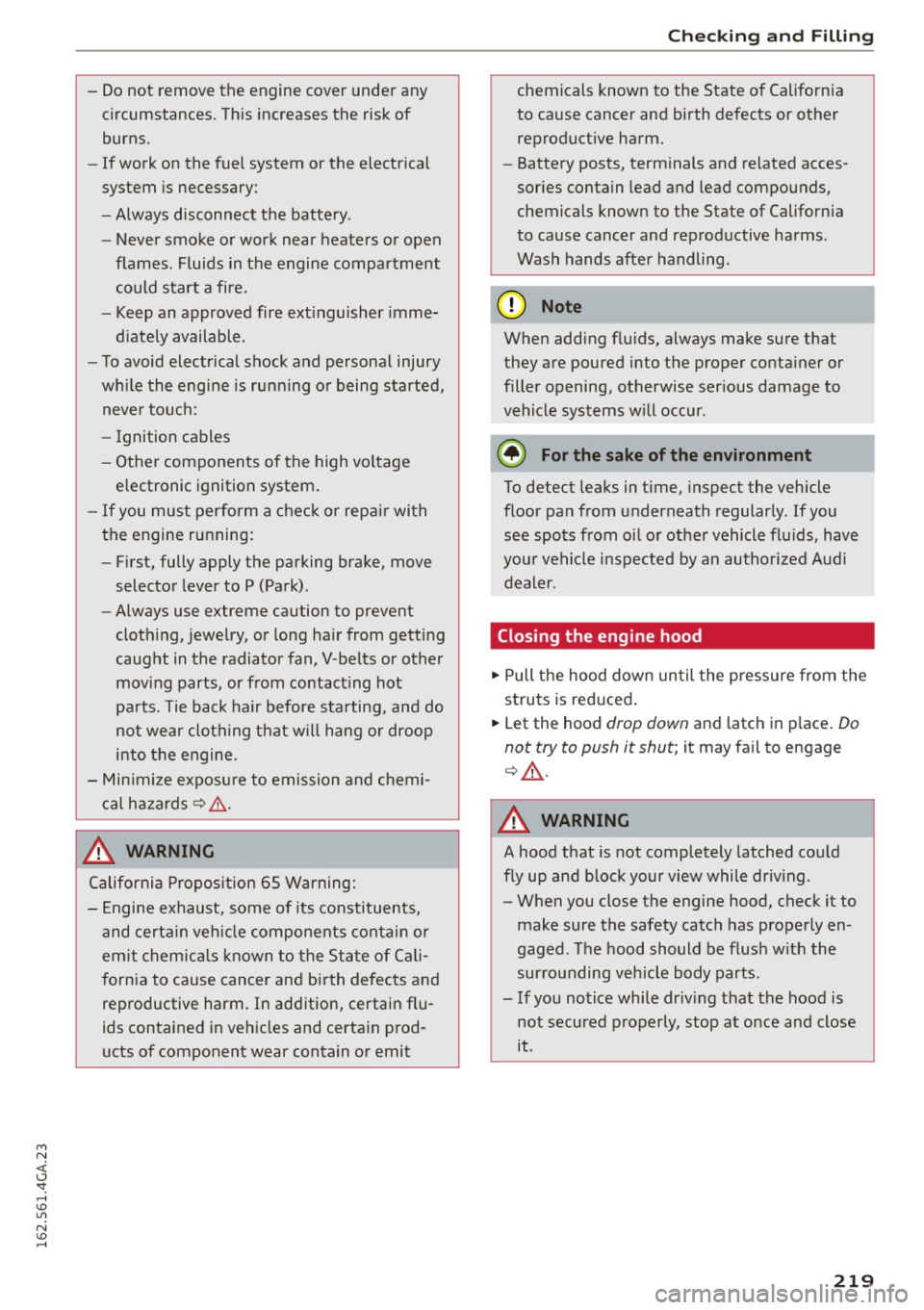
M N <( (.J
'SI: ,...., \!) 1.1'1
N \!) ,....,
-Do not remove the engine cover under any
circumstances. This increases the risk of
burns.
- If work on the fuel system or the electrical
system is necessary :
- Always disconnect the battery.
- Never smoke or work near heaters or open
flames . Fluids in the engine compartment
could start a fire.
- Keep an approved fire extinguisher imme
diately available.
- To avoid electrical shock and personal injury
while the engine is running or being started,
never touch:
- Ignition cables
- Other components of the high voltage
electronic ignition system.
-If you must perform a check or repair with
the engine running:
- First, fully apply the parking brake, move
selector lever to P (Park).
- Always use extreme caution to prevent
clothing, jewelry, or long hair from getting
caught in the radiator fan, V-belts or other moving parts, or from contacting hot
parts. Tie back hair before starting, and do
not wear clothing that will hang or droop
into the engine.
- Minimize exposure to emission and chemi
cal hazards ¢.&. .
..&, WARNING
California Proposition 65 Warning:
- Engine exhaust, some of its constituents,
and certain vehicle components contain or
emit chemicals known to the State of Cali
fornia to cause cancer and birth defects and
reproductive harm. In addition, certain flu
ids contained in vehicles and certain prod
ucts of component wear contain or emit
Checking and Filling
chemicals known to the State of California
to cause cancer and birth defects or other
reproductive harm.
- Battery posts, terminals and related acces
sories contain lead and lead compounds,
chemicals known to the State of California
to cause cancer and reproductive harms.
Wash hands after handling .
([) Note
When adding fluids, always make sure that
they are poured into the proper container or
filler opening, otherwise serious damage to
vehicle systems will occur .
® For the sake of the environment
To detect leaks in time, inspect the vehicle
floor pan from underneath regularly. If you
see spots from oil or other vehicle fluids, have
your vehicle inspected by an authorized Audi
dealer .
Closing the engine hood
.,.. Pull the hood down until the pressure from the
struts is reduced.
.,.. Let the hood
drop down and latch in place. Do
not try to push it shut;
it may fail to engage
¢ ,& .
..&, WARNING
--A hood that is not completely latched could
fly up and block your view while driving .
- When you close the engine hood, check it to
make sure the safety catch has properly en
gaged . The hood should be flush with the
surrounding vehicle body parts .
- If you notice while driving that the hood is
not secured properly, stop at once and close
it .
-
219
Page 222 of 294

Checking and Fill in g
Engine compartment
Engine compartment overview
These are the most important items that you can check .
Fig. 188 Typica l layou t fo r con tainers and en gin e oil fille r cap
@ Jump start point( -) with hex head Engine oi L
screw . . . . . . . . . . . . . . . . . . . . . . . 230 , 265
@ Jump start point(+) under a cover
@ Brake fluid reservoir (0)) ...... .
@ Eng ine oil filler cap
('t::71) .. .. .. .
® Coolant expansion tank (-L) .... .
@ Windshield/headlight washer con -
t .
(~ ) amer ~ ................. . .
230,265
227
222
224
231
The engine oil filler neck (item @) may be locat
ed in a different area depending on the version of
the engine .
A WARNING
Before you check anything in the engine com
partment, always read and heed all WARN
INGS~.&.
in Working in the engine compart
ment on page 218.
220
Engine oil specifications
The engine oil used must conform to exact speci
fications.
The service inte rval disp lay in the instr ument
cl us ter of your vehicle will inform you whe n it i s
time for an oi l change . We recommend that you
have your oil changed by an authorized A ud i Serv
i ce Advisor .
If you have to top off the o il between oi l changes,
use the Audi oil quality standard specifie d in the
table . ..,.
Page 223 of 294
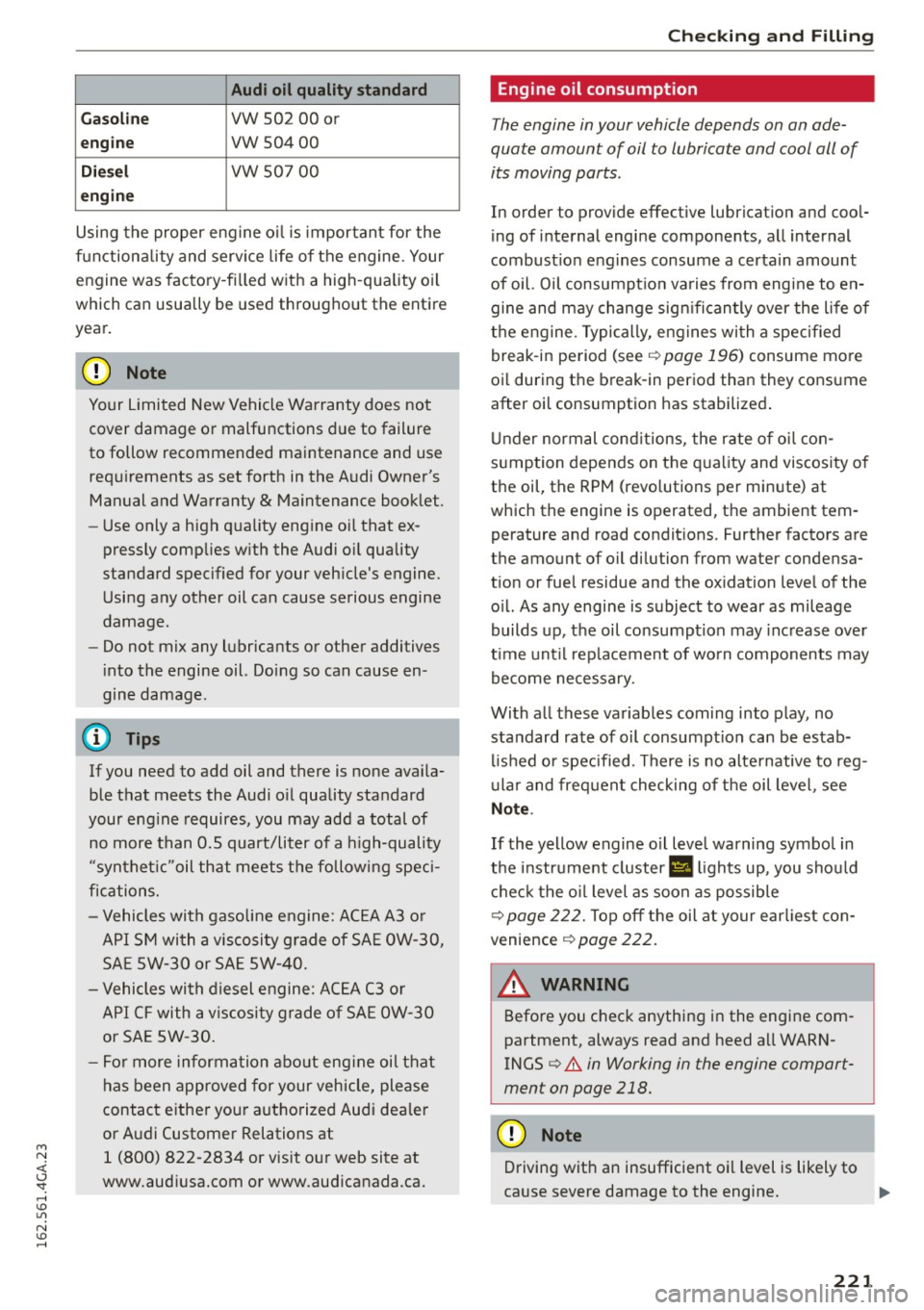
M N <( (.J
'SI: ,...., \!) 1.1"1
N \!) ,....,
Audi oil quality standard
G as oli ne
VW 502 00 or
engi ne vw 504 00
Diese l vw 507 00
eng in e
Using the proper engine o il is important for the
functiona lity and service life of the engine. Your
engine was factory-fi lled with a high-quality oil
which can usually be used throughout the entire
year.
@ Note
Your L imited New Vehicle Warranty does not
cover damage or malfunctions due to failure
to follow recommended maintenance and use
req uirements as set forth in the Audi Owner's
Manual and Warranty
& Maintenance booklet.
- Use only a high quality eng ine oil that ex-
pressly complies w ith the Audi o il quality
standard specified for your veh icle's engine.
Using any other oil can cause serious engine
damage .
- Do not mix any lubricants or other additives
into the engine oil. Doing so can cause en
gine damage.
(D Tips
If you need to add oil and there is none availa
ble that meets the Audi o il quality standard
your eng ine requires, you may add a total of
no more than 0.5 quart/liter of a high-quality
"synthet ic"oil that meets t he followi ng speci
fications.
- Vehicles with gaso line engine: ACEA A3 or
API SM with a viscosity g rade of SAE OW-30,
SAE SW-30 or SAE SW-40.
- Vehicles with diesel engine: AC EA C3 or
API CF with a v iscosi ty grade of SA E OW -30
or SA E SW-30.
- For more information abo ut eng ine oil that
has been approved for your vehicle, please
contact e ither your a uthorized Audi dea ler
or A udi Customer Relations at
1 (800) 822-2834 or visit our web site at
www.audiusa.com or www.aud icanada.ca.
Checking and Fillin g
Engine oil consumption
The engine in your vehicle depends on on ade
quate amount of oil to lubricate and cool oil of
its moving ports.
In order to provide effective lubricat ion and cool
i ng of internal engine components, all internal
combust ion eng ines consume a certain amount
of oil. Oil consumpt io n varies from eng ine to en
gine and may change sign ificantly over the life of
the engine. Typi cally, engines wi th a specified
break -in period (see
¢ page 196) consume more
o il during the b reak-in period than they consume
after oil consumption has stabilized .
Under normal cond itions, the rate of oil con
sumption depends on the quality and viscos ity of
the oil, the RPM (revolutions per min ute) at
which the engine is operated, the ambient tem
perature and road conditions. Further factors are
the amount of oil dilution from water condensa
t ion or fuel residue and the ox idation level of the
o il. As any engine is subject to wear as mileage
builds up, the oil consumption may increase over
t ime unt il replacement of worn components may
become necessary.
With all these variables coming into play, no
standard rate of oil consumpt ion can be estab
lished or spec ified . There is no alte rnative to reg
u la r and freq uent checking of the oil level, see
Note .
If the yellow engine o il leve l warning symbo l in
the instrument cluster
Ill li ghts up, you should
che ck the o il level as soon as possible
¢ page 222. Top off the oil at your earliest con
venience
¢ page 222.
A WARNING
--=-
Before you check anythi ng i n the engine com-
partment, always read and heed a ll WARN
INGS
¢ &. in Working in the engine comport
ment on page 218.
(D Note
Driving wit h an insufficient oil level is likely to
cause severe damage to the engine.
IJJ,,
221
Page 224 of 294
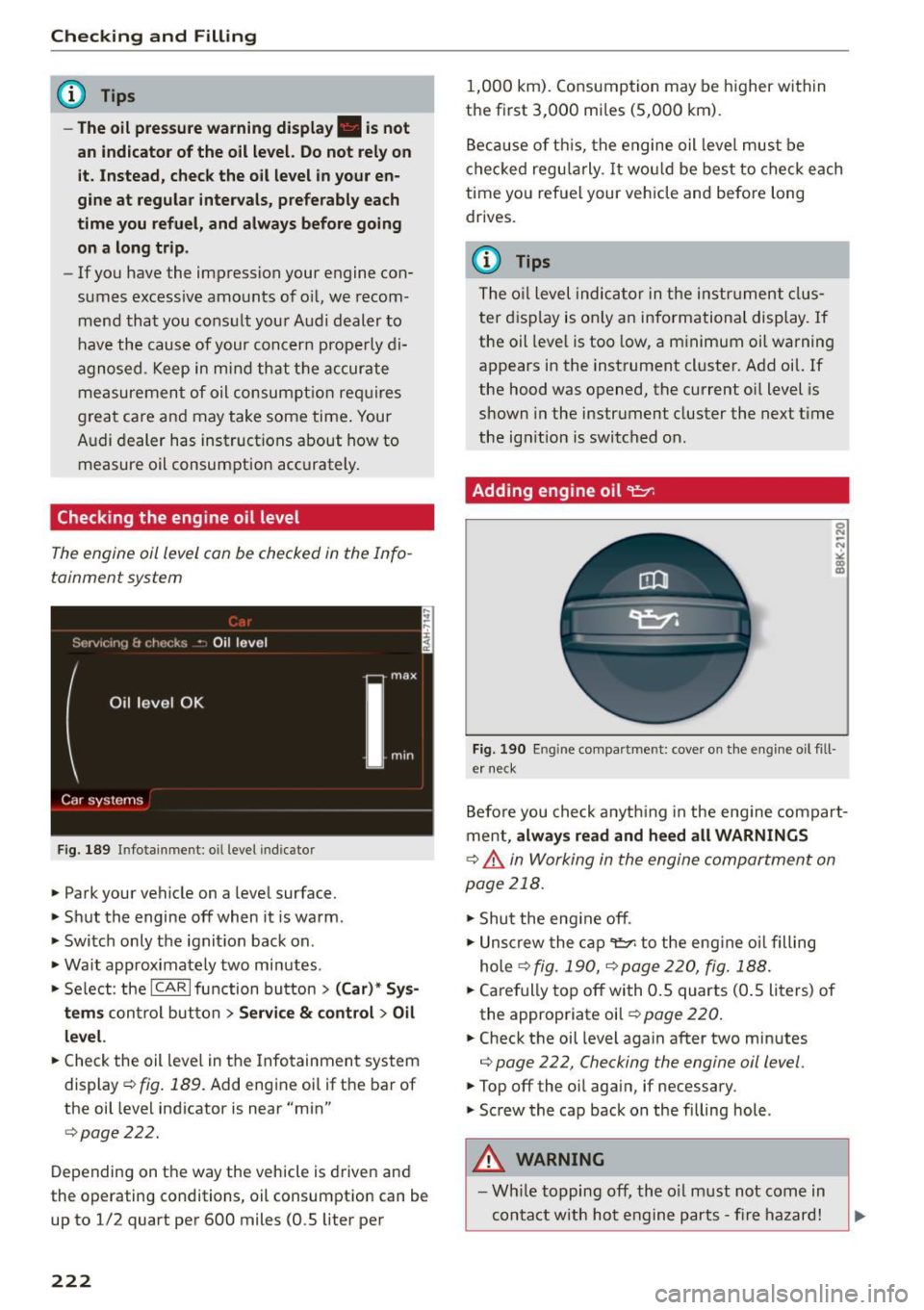
Checking and Fill in g
@ Tips
-The oil pre ssure warning displ ay. is not
a n ind icato r of the oil le vel. Do no t rel y on
i t. In stead , che ck the oil level i n your en
gine at regular inte rvals, preferab ly each
tim e you r efu el, and alway s befor e going
on a long trip .
-If you have the impression your engine con
sumes excess ive amounts of o il, we recom
mend that you cons ult your Audi dealer to
have the cause of your concern prope rly di
agnosed. Keep in mind that t he accurate
measurement of oil consumpt ion req uires
great care and may take some time . Your
A udi dealer has instructions about how to
measure oil consumption accurately.
Checking the eng ine oil level
The engine oil level can be checked in the Info
tainment system
F ig. 189 Infotainment: o il level indicato r
• Park your vehicle on a level surface.
• Shut the engine off when it is warm.
• Switch only the ignit ion back on .
• Wait approximately two minutes .
• Se lect : the
ICAR I function button > (C ar)* Sys
tem s
control but ton > S er vic e & con trol > O il
le vel.
• Check the oil leve l in the Info tainment system
display ¢
fig. 189. Add engine oil if the bar of
the oil level indicator is near "min"
r::!;>page222.
Depending on the way the vehicle is driven and
the operating conditions, oil consumption can be
up to 1/2 quart per 600 miles (0.5 liter per
222
1,000 km). Consumption may be h igher within
the first 3,000 miles (5,000 km).
Because of t his, the engine oil Leve l must be
chec ked regu larly . It wo uld be best to check each
time you refuel your vehicle and before long
drives .
{!) Tips
The oil level indicator in the instr ument clus
ter d isplay is only an informational display. If
the oil leve l is too low, a m inimum oil warning
appears in the instrument cluster. Add oil. If
the hood was opened, the current oi l Level is
shown in the instrument cluster the next ti me
the ignition is switched on.
Adding engine oil 'l:::1:
Fig. 190 Engine compart ment: cover on the engine oil fill
er neck
Before you check anyth ing in the eng ine compart
ment,
alwa ys read and h eed all WARN ING S
r::!;> .&. in Working in the engine compartment on
page 218.
• Shu t the eng ine off .
• Unscrew the cap~ to the eng ine oi l filling
hole
r::!;> fig. 190, r::!;> page 220, fig. 188.
• Carefully top off with 0 .5 quarts (0.S liters) of
the appropriate oil
r::!;> page 220.
• Check the oil level again after two minutes
r::!;> page 222, Checking the engine oil level.
• Top off the oil aga in, if necessary.
• Screw the cap back on the filling hole.
_&. WARNING
-Wh ile topping off, the o il must not come in
con tact with hot engine parts -fire hazard!
Page 225 of 294

M N <( (.J
'SI: ,...., \!) ..,.,
N \!) ,....,
-The oil fi ller ca p m ust be prope rly secure d to
preve nt oil from being sprayed on t he hot
eng ine and exhaust system when t he engine
is runn ing -fire haza rd!
- If your skin has come i n contact w ith the en
gine oil, you m ust subsequently clea nse it
th oroughly.
@ Note
-Check the oil level using the MMI. If the
message
Please red uce oil le vel a p pears,
contact your author ized Audi dealer or other
qualified workshop to have excess o il ex
tracted if necessary .
-Audi do es not recommend th e use of o il
additiv es. They ma y damage th e engin e
and ad ve rs e ly affect your New Vehicle War
rant y.
@ For the sake of the environment
-Under no circumstances can the o il come in
contact with the sewage network o r the soil.
- Observe and follow lega l regu lations whe n
dispos ing of empty oil conta iners.
Changing the engine oil
We recommend that have your oil changed by an
authorized Audi dealer or a qualified service sta
tion.
Before you check anything in the engine compart
ment,
alw ay s re ad and heed all WARNINGS c> .&.
in Working in the engine compartment on
page 218 .
The engine oil must be changed according to the
interva ls specified in your Warranty
& Mainte
n ance booklet . This is ve ry important because the
lub ricat ing propert ies of o il diminish gradually
du ring normal vehi cle use.
Unde r some circumstances the engine o il should
be changed more frequently. Change oil more of
ten if you d rive mostly short distances, ope rate
the vehicle in dusty areas or unde r predom inantly
s top-a nd-go tr aff ic condit io ns, o r have you r vehi
cle whe re temperatures rema in below freezing
for extended periods .
Checking and Fillin g
Detergent additives in the oil will make fresh oil
l ook dark after the engine has been running for a
sho rt time. Th is is norma l and is not a reason to
change the oi l more often than recommended.
Beca use of the p roblem of p roper disposal, along
with t he specia l too ls and necessary expertise re
quired, we strongly recommend that yo u have
yo ur o il changed by an authorized
Audi dealer or
a qua lified service station.
If y ou choo se to change your oil yourself , please
note the following important informat ion:
A WARNING "--
To reduce the risk of personal in jury if you
must change the eng ine oi l in your vehicle
yourself:
- Wear eye protect ion.
-
- To reduce the risk of burns from hot eng ine
oil, let the engine coo l down to the touch.
- W hen removing the o il dra in p lug with your
f ingers, stay as far away as possib le. Always
keep yo ur forearm parallel to the ground to
he lp prevent hot o il from running down your
arm.
- Dra in the oil into a container designed for
this purpose, one la rge enough to hold at
least the tota l amou nt of oil in yo ur engine.
- Engine oil is poisonous . Keep it we ll out of
the reach of ch ild ren .
- Continuous contact wit h used eng ine o il is
harmful to your skin. Always protect your
skin by washing oil off thoro ughly wi th soap
a nd water .
«I) Note
Never mix oil additives with yo ur engine oil.
These additives can damage your engine and
adverse ly affect your Aud i Limited New Vehi
cle Warranty.
@ For the sake of the environment
- Before changi ng your oil, first make sure
you know where you can prope rly dispose of
the used oi l.
- Always dispose of used eng ine oi l properly.
Do not dump it o n ga rden soi l, wooded
223
Page 226 of 294
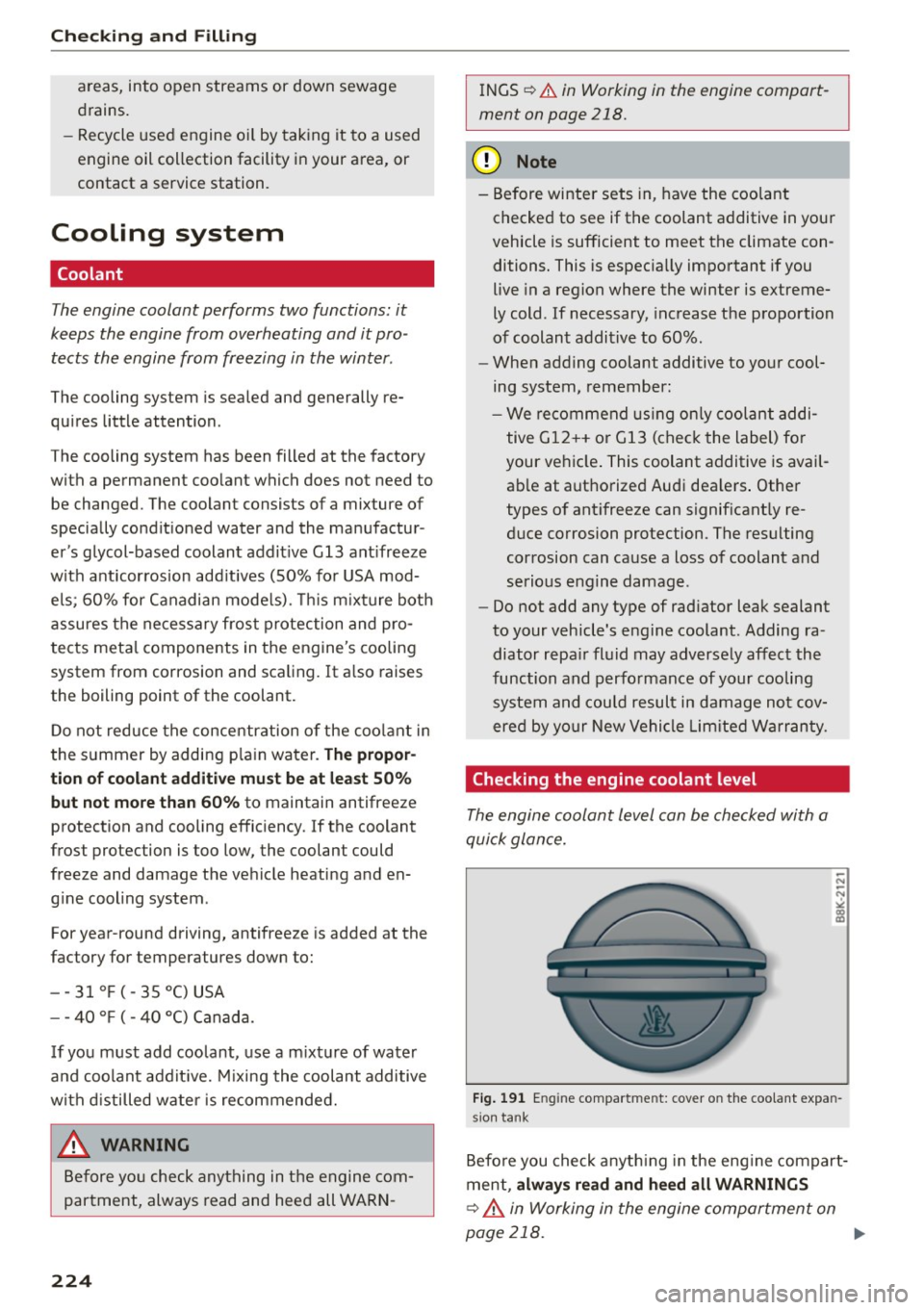
Checking and F ill in g
areas, into open streams or down sewage
drains.
- Recycle used engine o il by taking it to a used
engine oil collection facility in your area, or
contact a service station.
Cooling system
Coolant
T he engine coolant performs two functions: it
keeps the engine from overheating and it pro
tects the engine from freezing in the winter .
The cooling sys tem is sealed and generally re
qu ires little attention .
T he cooling system has been filled at the facto ry
with a permanent coo lant wh ich does not need to
be changed . T he coolan t consists of a mixture of
specially condit ioned water and the manufactur
er's glycol-based coolant addit ive Gl3 ant ifreeze
with a nticorrosion add itives (50% fo r USA mod
e ls · 60% for Canadian mode ls). Thi s m ix tu re both
'
assures the ne cessary fros t protection and pro -
t ects meta l components in t he engine's cooling
system from corrosion and scaling. It a lso raises
the boiling point of the coolant.
D o not reduce the concentr ation o f the coo lant in
the summer by addi ng p la in water.
The propor
tion of coolant additive must be at least 50 %
but not more than 60 %
to maintain antifreeze
protection and cooling efficiency .
If the coolant
frost protection is too low, the coolant could
freeze and damage the ve hicle heati ng and en
g ine cooling system .
For year-round driving, antifreeze is added at the
factory for tempera tures down to:
- -3 1 °F (- 35°C)USA
- - 4 0 °F ( - 4 0 °C) Canada.
I f you must add coo lant, use a m ixt ur e of wate r
a nd coolant add it ive. Mixing the coolant additive
w ith d istilled w ate r is recommended.
_& WARNING
Before yo u check any thing in t he engine com
par tment, always read and hee d all WA RN -
224
INGS ~ &. in Working in the engine compart
ment on page 218.
(D Note
- Be fore wi nter sets in, have the coo lant
checke d to see if the coolant additive in you r
vehicle is sufficient to meet the climate con ditions. This is espec ia lly impo rtant if you
live in a region where the winter is extreme
ly cold . If necessary, increase the p roportion
of coolan t addit ive to 60% .
- Whe n adding coolant additive to your cool
ing system, remember:
- We re commend usin g on ly cool ant addi
tive Gl2++ o r Gl3 (chec k the label) fo r
your ve hicle. This coo lant additive is avai l
ab le at aut horized Aud i dea le rs . Othe r
types of ant ifreeze can significant ly re
d uce co rrosion protection. The resulting
corrosion can cause a loss of coolant a nd
serious e ngine damage .
- Do not add any type of rad iator leak sealant
to your vehicle's engine coolant. Adding ra
diator repa ir fl uid may adverse ly affec t the
func tion and perfo rmance of your cooling
system a nd could result in d amage not cov
ere d by yo ur N ew Vehi cle Lim ited War ranty.
Checking the engine coolant level
The engine coolant level can be checked with a
quick glance.
Fi g. 1 91 Eng ine co mpar tmen t: c over on t he coo la nt expa n
sio n tan k
Befo re you check a nyth ing in the eng ine compart
men t,
always read and he ed all WARNINGS
~ A in Working in the engine compartmen t on
page 218. ..,.
Page 227 of 294
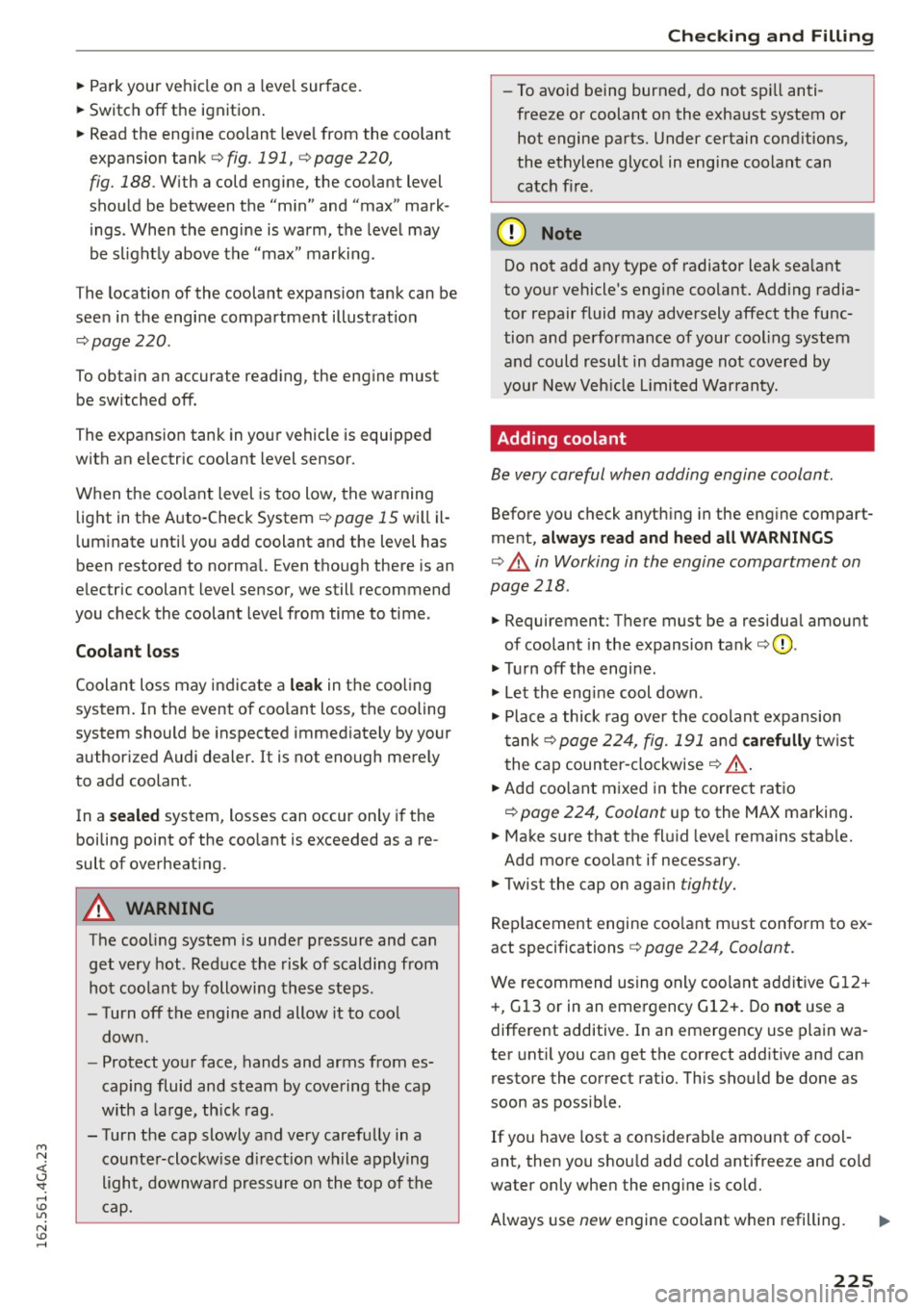
M N <( (.J
'SI: ,...., \!) 1.1'1
N \!) ,....,
~ Park your vehicle on a level surface.
~ Switch off the ignition .
~ Read the eng ine coolant leve l from the coolant
expansion tank
c> fig. 191, c> page 220,
fig. 188.
With a cold engine, the coolant level
should be between the "min" and "max" mark
i ngs. When the engine is warm, the level may
be s light ly above the "max" marking.
The location of the coolant expans ion tank can be
seen in the engine compartment illustrat ion
i=>page220.
To obtain an accurate reading, the engine must
be sw itched
off.
The expansion tank in you r vehicle is equipped
with an electric coolant level sensor.
When the coo lant level is too low, the warning
light in the Auto-Check System
c:> page 15 wi ll il
l uminate unti l you a dd coolant and the level has
been restored to norma l. Even though there is an
e lectric coolant level sensor, we still recommend
you check the coolant level from time to time.
Coolant loss
Coolant loss may i ndicate a leak in the coo ling
system . In the event of coo lant loss , the cooling
system should be inspected immed iate ly by your
author ized Audi dealer. It is not enough merely
to add coolant .
In a
sealed system, losses can occur only if the
boiling point of the coo lant is exceeded as a re
sult of overheat ing.
A WARNING
The cooling system is under pressure and can
get very hot. Reduce the risk of scalding from
hot coolant by following thes e steps.
- Turn off the engine and allow it to coo l
dow n.
- Protect yo ur face, hands and arms from es
caping fluid and steam by cove ring the cap
with a la rge, th ick rag.
- Turn the cap slowly and ve ry carefu lly in a
counte r-clockw ise direct io n wh ile a pplying
light, downwa rd pr essur e on the top of the
c ap.
Checking and Fillin g
-To avo id being burned, do not sp ill anti
freeze o r coolant on the exha ust system or
hot engine parts. Under certa in cond itions,
the ethylene glyco l in engi ne coo lant can
ca tch fire.
(D Note
Do not add any type o f radiator leak sea lant
to you r vehicle 's engi ne coolant . Add ing radia
tor repair fluid may adversely affect the func
tion and pe rformance of your coo ling system
and could r esult in damag e not cover ed by
your New Veh icle Limited Warranty.
Adding coolant
Be very careful when adding engine coolant.
Before you check a nyth ing in the eng ine compart
me nt,
always read and heed all WARNINGS
c> .&. in Working in the engine compartment on
page 218.
~ Requirement: T here must be a residua l amount
of coolant in the expansion tank
c:> (D .
~Tu rnoff the engi ne.
~ Le t the eng ine cool down.
~ Place a thick rag ove r the coo lan t expansion
t ank
c:>page 224, fig. 191 and carefully tw ist
t he cap coun ter- clockwise
c:> .&, .
~ Ad d coo lant mixed in the correc t ra tio
c:> page 224, Coolant up to the MAX marking .
~ Make sure that the fl uid leve l remains stab le.
Add more coo lant if necessary.
~ Twist the cap o n again tightly.
Rep lacement engine coo lant must confo rm to ex
act specifications
c> page 224, Coolant.
We recommend using only coo lant add it ive G1 2+
+ , G 13 or in an emergency G12+. Do
not use a
different additive. In an emergency use p lain wa
ter unt il you can get the correct add itive and can
restore the correct ratio. This should be done as
soon as possib le.
If you have lost a considerab le amou nt of cool
ant, then you shou ld add cold antifreeze and co ld
water only whe n the eng ine is co ld.
Always use
new engine coo lant w hen refilling.
225
Page 228 of 294

Checking and Filling
Do not fill coolant above the "MAX" mark. Excess
coolant will be forced out through the pressure relief valve in the cap when the engine becomes
hot.
A WARNING
- The cooling system is under pressure and
can get very hot. Reduce the risk of scalding
from hot coolant by following these steps .
- Turn off the engine and allow it to cool
down.
- Protect your face, hands and arms from
escaping fluid and steam by covering the
cap with a large, thick rag.
- Turn the cap slowly and very carefully in a
counter-clockwise direction while applying light, downward pressure on the top of
the cap.
- To avoid being burned, do not spill anti
freeze or coolant on the exhaust system or
hot engine parts. Under certain condi
tions, the ethylene glycol in engine cool
ant can catch fire .
-Antifreeze is poisonous. Always store anti
freeze in its original container and well out
of the reach of children .
- If you drain the coolant, it must be caught
and safely stored in a proper container
clearly marked "poison" .
(D Note
- Do not add coolant if the expansion tank is empty. Air could enter the cooling system
and damage the engine. If this is the case,
do not continue driving. Seek professional
assistance .
- Coolant pollutes the environment and could cause an engine fire. Excess coolant will be
forced out through the pressure relief valve
in the cap when the engine becomes hot.
- If, in an emergency, only water can be add
ed, the correct ratio between water and an
tifreeze
¢ page 224 must be restored as
soon as possible.
226
-
® For the sake of the environment
Drained coolant should not be reused. Always
dispose of used coolant while observing all
environmental regulations.
Radiator fan
The radiator fan switches on automatically by it
self
An auxiliary electric radiator fan switches on and
off depending on coolant temperature and other
vehicle operating conditions.
After you switch the engine off, the auxiliary fan
can continue running for up to 10 minutes -even
with the ignition off. It can even switch on again later by itself ¢& . if
- the temperature of the engine coolant rises due
to the heat build-up from the engine in the en
gine compartment, or
- the engine compartment heats up because the
vehicle is parked in intense sunlight.
A WARNING
- To reduce the risk of personal injury never
touch the radiator fan.
- The auxiliary electric fan is temperature con
trolled and can switch on suddenly even
when the engine is not running.
- The auxiliary radiator fan switches on auto
matically when the engine coolant reaches a
certain temperature and will continue to run
until the coolant temperature drops. -